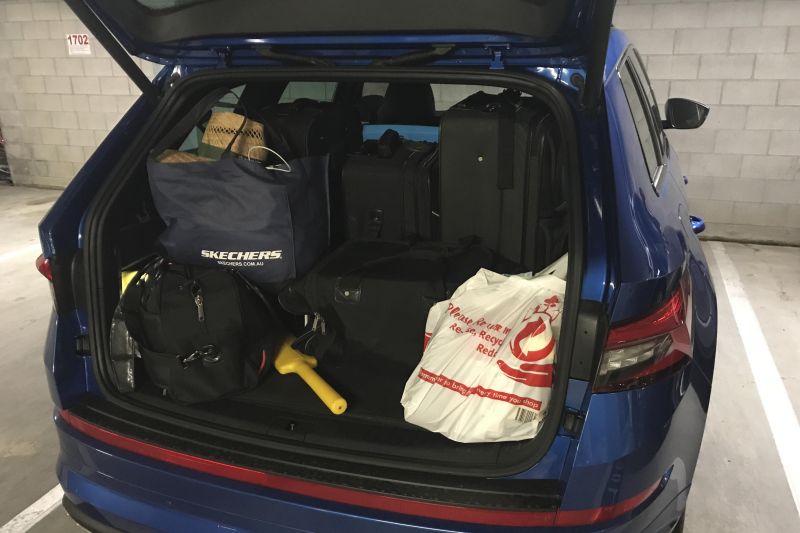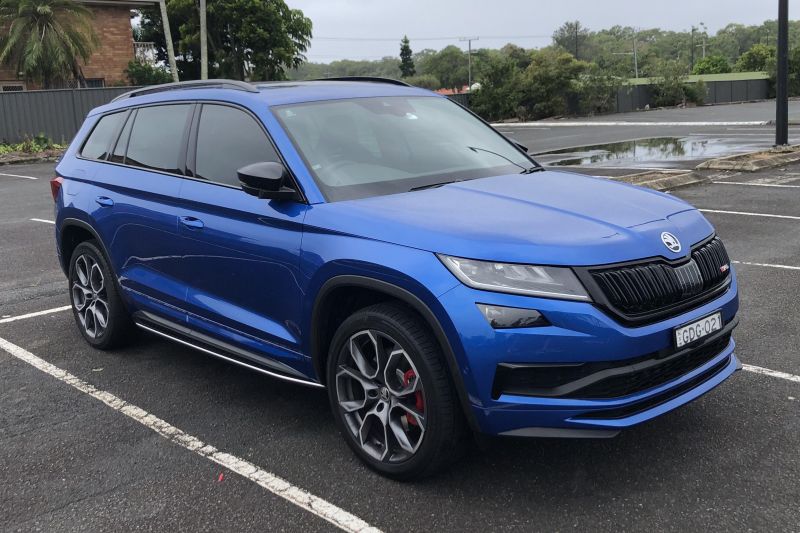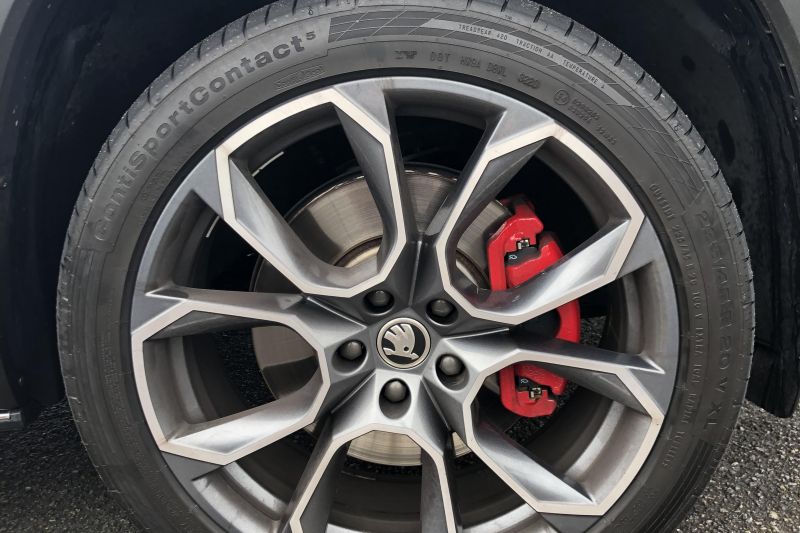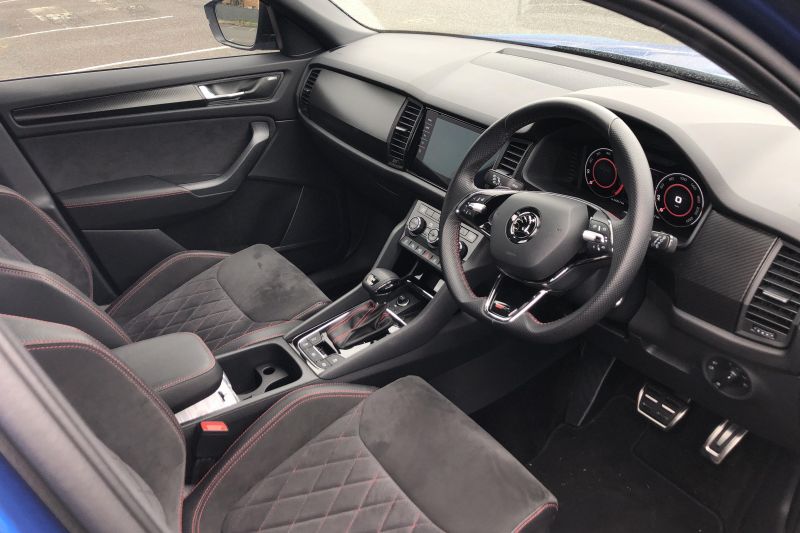About the Skoda Kodiaq
James Gelding purchased this Skoda Kodiaq new for $72,000 (including all on-road costs). James Gelding would buy this car again because: “The Kodiaq RS has so far been a great family SUV, easily able to soak up the highway kilometres on road trips while also being well mannered around town. Its convenient size and smart interior packaging make it a great family hauler. “
How reliable has your car been? Tell us about any issues.
Our Kodiaq RS is still relatively new, with only about 15,000 kilometres on the clock. The car’s 2.0L twin-turbo diesel is also unproven as the Kodiaq RS is the first Volkswagen Group vehicle to feature the powertrain in Australia. That being said, we have had no reliability issues.
Of note though is the engine cooling fans, which will continue to run for a couple minutes after the car has been switched off. I presume this is to gradually cool the engine and turbos and thereby extend the life of those components. But it’s a noteworthy point as passers-by have mistaken this for us leaving the car running by accident.
What do you think of the ownership experience with your car?
Even though the car doesn’t have many kilometres on it, it is approaching 12 months old. During this time, the only ‘issue’ we’ve had is that the infotainment screen has occasionally blacked out and glitched when we first got the car. But that issue appears to have fixed itself and doesn’t occur anymore. No other issues have occurred during our ownership.
How has the purchase and aftercare experience been with your car?
The purchase experience has been worry-free and the car is approaching its first service interval. Being petrol heads, my father and I have topped up the engine oil and coolant, but this would presumably be done in the first service resulting in the average owner not needing to worry about such things.
The car we owned prior to this Kodiaq RS was a ‘regular’ petrol Kodiaq 132 TSI, and we were unimpressed with the cost of servicing, including having to replace the brake pads after only a couple of years of service, at roughly $1100 dollars (pads and rotors are replaced together).
Therefore, with the Kodiaq RS, we negotiated the inclusion of Skoda’s service plan at the time of purchase, which includes the cost of scheduled servicing for the first three years.
Are you happy with the price and features of your car?
Yes, we love how the Kodiaq has a smartly packaged interior. The interior is spacious with plenty of head and leg room in first and second rows (a six foot person can easily sit behind the driver of a similar size). There is also plenty of storage in the twin gloveboxes (one being cooled), centre console, door bins and separate spaces for phones and bottles.
The second row of seats can slide back and forwards and there is even a sixth and seventh seat suitable for children. Additionally, the second row is always comfortable with three-zone climate control.
With the third row folded down (can be split folded if needed), there is an impressive amount of boot space, easily enough for the family’s luggage. For families that occasionally need seven seats for ferrying children, the Kodiaq remains a more economical choice rather than forking out for a similarly specced full sized seven-seat SUV.
The interior is high quality and ergonomically laid out. Nothing rattles as you drive over rough roads and the splashes of piano black plastic and fake carbon fibre make it look suitably premium. The high-resolution centre screen and digital dash only compliment the upmarket vibes although there are still some scratchy plastics found lower down in the cabin.
What do you think of the performance and economy of your car?
As touched on briefly before, my family upgraded to the RS Kodiaq from a petrol 132TSI Kodiaq in the hopes the RS would have the grunt that the petrol Kodiaq unfortunately lacks. I am happy to report the 2.0L twin sequential turbo four-cylinder diesel engine is a great match for the car.
With 176kW and 500Nm of torque available low down in the rev range, it performs like an engine with twice its displacement. The 176TDI has a strong mid-range and while it doesn’t pull relentlessly to redline, it doesn’t fall on its face at higher revs. The addition of the second turbo makes the engine feel so much stronger than the 140TDI unit found in other Kodiaqs.
Switch into normal mode and the powertrain propels the car effortlessly and regularly achieves 600km to a tank of diesel around town. On the highway, the range stretches to 900km or more.
For those who are hesitant about the dual-clutch automatic, don’t be. The transmission is very well mannered around town with the car taking off smoothly every time. It changes gear quickly without a fuss, allowing the diesel to keep in its torque band. In sport mode the car feels more responsive, and the transmission holds gears longer.
If I had one complaint, I wish the transmission downshifted sooner under load but you can rarely fault its gear selection.
What do you think of the technology in your car?
The Kodiaq RS has all the technology expected of a modern SUV. The infotainment screen is clear and easy to use, and doesn’t leave you feeling short changed, with features such as wireless Apple CarPlay and excellent 360 degree surround view camera.
The digital dashboard is easy to read and has multiple viewing modes. There are also some handy ‘quirks’ unique to the Kodiaq. For example, umbrellas in the front doors, pull up sun shades on the rear windows and rubber door protectors that deploy when the doors are opened. Overall, the Kodiaq has every feature you’d expect from a modern SUV but unfortunately misses out on the driver profiles found on pre-interior facelifted Kodiaqs.
While the majority of the Kodiaq’s technology works as advertised, some features could be perfected.
For one, the adaptive cruise control could be better programmed to recognise when the surrounding traffic is in your own lane or an adjacent lane. The cruise control frequently gets this confused and starts to ‘phantom brake’ to maintain a safe gap between a car that is actually in the lane next to you. (Have you checked if it has “undertake prevention”, where it won’t pass in the left lane – Ed?)
Another annoying issue is the infotainment gets confused when several phones are connected to the car via Bluetooth. This results in the phone playing audio through the stereo getting frequently disconnected and then reconnected again.
What do you think of the ride comfort and handling of your car?
With its adaptive suspension, the Kodiaq RS has its bases covered for most road surfaces. Normal mode delivers a comfy, compliant ride that will be subtle enough for most road conditions. However, dial up the pace and there is a little bit of natural body roll and float to the ride.
Switch into sport and the rides firms up considerably, allowing the car to feel flat during corners (but might annoy your passengers with how firm it is). Comfort mode is slightly better at small bump absorption but is too bouncy for my tastes during normal driving. The driving experience is complimented with awesome sport seats which hug the body perfectly.
Additionally, the brakes don’t feel overly sensitive and remain as approachable as the regular Kodiaq. They bite as soon as you press the pedal and feel confidence inspiring during spirited driving.
The Continental Sport Contact 5 tyres make a big difference to the handling of the RS compared to lesser Kodiaqs. They have superior grip in all conditions, especially in the wet, which is a very worthy trade-off for the increase in tyre noise at higher speeds.
The steering also matches the character of the vehicle. It has a good ratio allowing the driver to take most turns without crossing arms and is accurate but slightly lacking feel. It is well weighted in normal mode and weights up artificially in sport.
Sport can take some getting used to as the weight builds considerably off centre.
Do you have any additional comments about your car?
While the car is badged ‘RS’, don’t expect the Kodiaq RS to be as devoted to sporting ambitions as for example the Skoda Octavia RS.
Instead, the Kodiaq RS can be thought of as an equivalent to Audi’s S range rather than the fully fledged RS range.
However, there is a facelifted Kodiaq RS just about to hit dealer showrooms. The new model receives the 2.0L turbo petrol similar to the Octavia RS and Audi A4. Only time will tell if the new engine turns the Kodiaq RS into a more potent performer.
Regardless, the current generation RS remains a great proposition for families who want a little more performance from their SUV without sacrificing comfort for under $80k.








